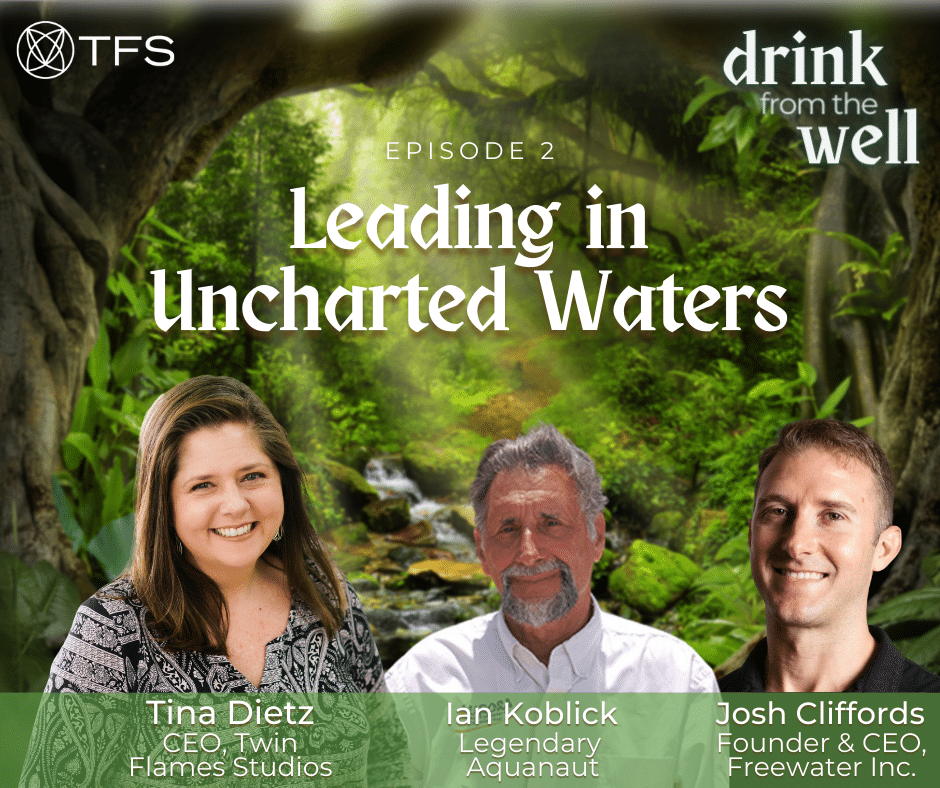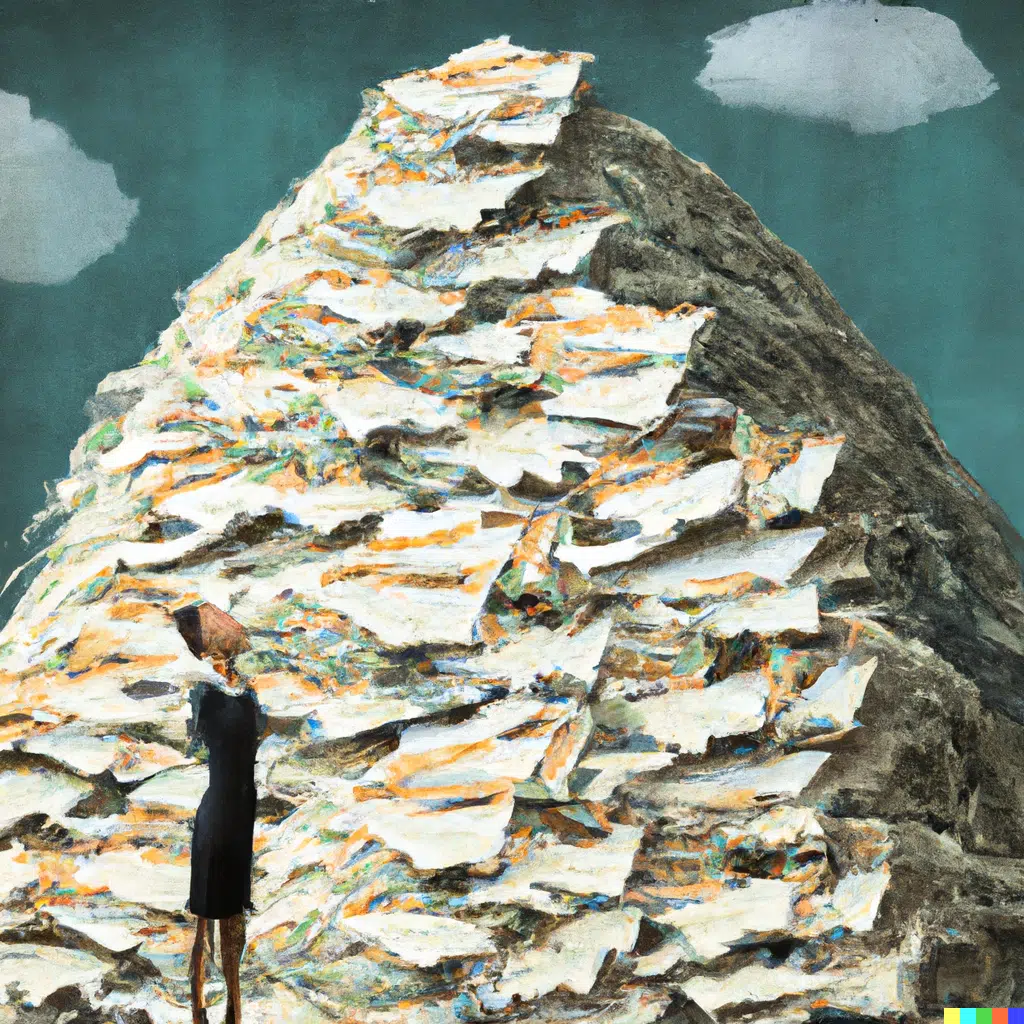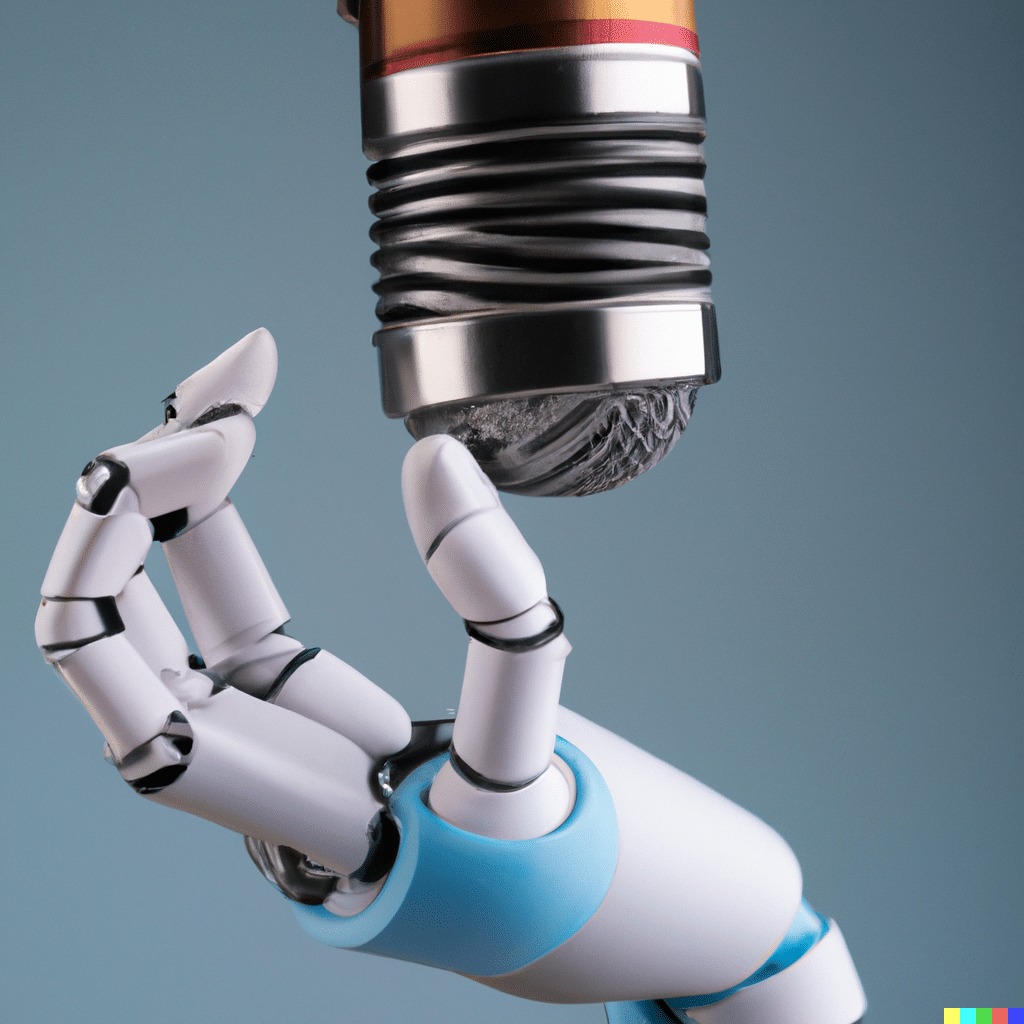Leading in Uncharted Waters
Can conservation, activism, and capitalism coexist? Legendary Aquanaut Ian Koblick and Josh Cliffords, Founder of industry disruptor Free Water discussing their takes on vital questions for our future, such as how leaders today are pushing boundaries, innovating, and making inroads to change our future on this planet, and how we can make a difference in the world when our future is so uncertain.
Don't miss our Leaders' Discussion Guide for this episode below – perfect for your next team Lunch & Learn!
Leading in Uncharted Waters – Episode Highlights
- Discover how conservation, activism, and capitalism can coexist (8:47)
- Learn how leaders today push boundaries, innovate, and make inroads to change our future on this planet (15:43)
- See what type of leadership style leads to success (19:24)
- Find out how to make a difference in the world when our future is uncertain (21:26)
Full Transcript
Tina Dietz
Ah, the ocean, so calming, so relaxing. It's a wonderful reminder that the turning tides of life can calm into beautiful, soft waves — until we remember the pollution and the overfishing and the coral reefs that are dying off faster than we can speak, and according to scientists, climate change will become irreversible by 2030. Holy crap! That's in seven years and — Okay, hang on now. Deep breath with me. Freaking out isn't going to help. Right? Right. But what will help are leaders who are willing to push the boundaries of conservation and humanitarianism, create innovation and action, and lead in uncharted waters.
Today on Drink From the Well, we're exploring some vitally important questions for our future on this planet as humans. There's a drop of inspiration, a dash of creativity, plenty of communication, and there you have it, our executive elixir. This is Drink From the Well. How can we make a difference in the world when our future is so uncertain? Can conservation, activism, and capitalism coexist? How are leaders today pushing boundaries, innovating, and making inroads to change our future on this planet? As we begin, let's go back to our ocean. Thanks, ocean. It's no secret that massive changes have happened in the ocean in the last 50 years. But don't just take my word for it.
Ian Koblick
Seas are dying, and not enough people are out there trying to take care of it or preventing it. And as I've said, now, for almost 40 years, if the seas go, they're our last resource for food, water, energy, and medicine.
Tina Dietz
That was Ian Koblick. You might not have heard of Ian. But anyone who has spent time in the world of ocean conservation sure has. He has been an instrumental leader in ocean exploration and conservation for over 50 years, a lifetime of creating and managing educational facilities and leading conservation efforts in order to advance public knowledge and understanding of the ocean environment and its importance.
Ian Koblick
…Anniversary of the underwater lab facility, which is the underwater hotel.
Tina Dietz
And yes, you heard that right. He has an underwater hotel. More on that later.
Ian Koblick
The second thing is that we're celebrating our 52nd anniversary of our nonprofit foundation, Marine Resources, which runs marine education programs for over 5000 kids a year, pandemic years not included. And then, I'm deeply involved on the board of directors and run some of the programs with a new foundation called OCEEF, OCEEF.org. OCEEF has just acquired Ray Dalio, the billionaire's research vessel, which was previously called the Alucia. Now, it's called the Odyssey, and that is off going around the world doing research and education programs and marine archaeology.
Tina Dietz
How exactly do you get a billionaire to donate a multimillion-dollar state-of-the-art research vessel to your organization? For Ian, his success comes down to networking and creating relationships that push innovation forward.
Ian Koblick
Think of me as an orchestra conductor. I don't play an instrument. I have always been a behind-the-scenes person. I've been the President of Marine Resources now, and the Founding Director, for 52 years. My networking, my contacts, I mean, I was a special assistant to the governor of the Virgin Islands, I spent a lot of time in Washington consulting and was a consulting editor of the NOAA Diving Manual, all those things have brought personalities that are now friends. We were working with Ray Dalio's foundation to acquire their ship and that kind of stalled and stalled and stalled. In the meantime, we met a person who wanted to use a ship like that to take his family around the world so they could be educated. Well, that evolved and evolved.
Tina Dietz
Despite all of Ian's involvement, he's still only one man. It's not enough to prevent the whole world's oceans from continuing to decline. But the light at the end of the tunnel is seeing the fruits of his leadership.
Ian Koblick
We have had more than 180,000 students and teachers attend our programs here. So when they came in, they were only this big, they now come back with their kids that are that big. And they say, “This is where it all started, this is how I became a science teacher. This is how I became an engineer. This is how I became a marine geologist.” It all started by dipping your head in the water and explaining to them and showing them the excitement of the ocean. And you cannot believe how many of our students have turned into major leaders in the United States in environmental programs and in education. But that's a small number.
Tina Dietz
Conservation focuses heavily on education and revitalization. Think zoos and aquariums. But while education is vitally important, it doesn't reach as many people as, say, a viral video.
Clip from Viral Video
Hello, friends and welcome to another video. This week, we're going to be journeying to a completely underwater hotel and staying there overnight. That's right. Tonight, we're going to be sleeping with the fishes. Now, it's been a while since we've…
Ian Koblick
You will see exactly, the philosophy is not how deep can we go? Or, how many samples of water quality can we take? It's how can we develop interesting, real science programs and education programs that will attract millions and millions of individuals? So we're looking at millions, not thousands, millions, and millions.
Tina Dietz
When we come back, we'll discuss how Ian is now reaching millions and millions of people using, what else? That underwater hotel. Welcome back. Let's dive right in. Pun completely intended. Like your average hotel, Jules' Undersea Lodge has Wi-Fi, a TV, a shower, and a bedroom. Unlike a normal hotel, visitors must enter by scuba diving five feet below the surface. You can even request the services of a mer-chef who will scuba dive into the hotel and cook you a meal. The hotel started out as a research lab, but since it was converted into a hotel, Jules' Undersea Lodge has hosted a deluge of curious clientele. The novelty of the underwater hotel brought us into conversation with Ian in the first place. We were not the first to be intrigued. YouTube influencer, Ryan Trahan, came and stayed at Jules' Underwater Lodge and shared his experience in a video that went viral to the tune of 24 million views.
Clip from Viral Video
In fact, this hotel is the only underwater hotel in America. It used to be this ocean research lab in the '80s, and then they said, “Screw it. Let's make this the first-ever underwater hotel in the world.” And voila, Jules' Undersea Lodge was born. This might be the coolest thing I've ever seen, and I'm going to spend the freaking night in it. Right now. Here's my Get Ready With Me.
Tina Dietz
Whether you love it or hate it, we're living in an influencer culture. Jules' Undersea Lodge is leveraging our curiosity and using it to bring more people into the world of ocean conservation.
Ian Koblick
I didn't know what influencers were until about two months ago. However, we started with the hotel, bringing influencers, and we just did one with a following of 9 million. They weren't divers so they were introduced, they did a resort course, and it's all documented. How do you get involved in the ocean? Come and see us in The Keys. And I'm going to really work on that direction of utilizing the influencers that already have huge followings to promote the programs that we're trying to get across.
Tina Dietz
Here's a really big question. Can capitalism and conservation coexist peacefully? Josh Cliffords is proving that it works. He's the founder of Free Water, the world's first free beverage company. It might sound too good to be true, but Josh proves it's possible to have a profitable business, give your product away for free, and fund conservation efforts simultaneously. It all has to do with finding positives in the negative.
Josh Cliffords
So I started a nonprofit organization in Eastern Europe called Save the Refugees, and we found that roughly 20% of them or more had left their country because they didn't have access to water, food, or medicine. And after hearing the same story over and over again, we were compelled to do some research and figure out how many people this could affect. But we couldn't get a straight answer so we made a guesstimation that roughly 40 million people die every year around the world because of this, but meanwhile, here in the United States, we're some of the biggest wasters in the world. We throw away $60 billion of food in the trash every year. 33% of all food in the supermarket goes from the supermarket shelf and into the trash because it's too expensive. So I was thinking, “Hey, how can we kind of kill two birds with one stone? How can we cut the waste? And how could we save lives?” And so the goal was to create a system that made saving a life as simple as eating a free slice of pizza.
Tina Dietz
And now we're here. You might be wondering why Josh created a company to combat world hunger when the obvious step was to create a charity. Why go in this particular direction, instead?
Josh Cliffords
I have founded two nonprofits in the past. One was in California to help obese children, which was a huge failure. And the second one was this nonprofit with the refugees. And from my limited experience with both of those organizations, the issue with the nonprofit is when you run out of money, you're out of operation. So I was also looking at it from a different perspective. I thought, “Well, hey, there's been a lot of nonprofits that have been around for roughly 100 years. Why hasn't the Red Cross, quote, unquote, saved the world? How come companies like Uber were able to scale across the world in a decade or less?” Because of that, I figured it had to be a for-profit solution. But if done right, it could be more philanthropic than most nonprofits.
It didn't happen overnight. There was a series of events that happened. But mainly the inspiration came from knowing that it had to be Better Than Free, and Better Than Free is actually the parent company of our organization. I looked at it two ways. Number one, they say in capitalism, everything is a zero-sum game. So there's one winner, one loser. I didn't want to deal with that. So I decided I was going to create a new system that had a new set of attributes. When I started realizing, maybe we could go negative, because, in software, there's actually some negatively priced software such as Ecosia, which is Germany's search engine. It's not a competitor with Google, but it's free, and it donates like 70% of its revenue or profit to charity. So I looked at that, like, wow, that's negative 170% off. But what I realized is in capitalism, or just when things cost money, if two companies are competing, what are they competing at? I didn't think it was very positive. But if you go negative, the only way to make this better than zero is to pay you directly or donate to charity. There's no other way to make a physical product negative. So I thought, okay, if people or companies start competing in this negative zone, now they're competing to help the consumer, strengthen the local economy, help the environment, and donate to charity. That's the kind of competition we wanted to involve ourselves in. And I also knew that Coke, Pepsi, Nestle, Uber, Nike, any company, if you just went free, you're making it easier to copy. But if you go negative, they're not built to compete in that realm, and so it just works well.
Tina Dietz
When I first heard about Josh and Free Water, I had a hard time wrapping my head around the idea of a negatively priced product. How is it possible to end up with a free bottle of water in my hand? I had to find out how it worked.
Josh Cliffords
Free Water is our first product and the water is free because the packaging is the ad space. We do aluminum bottles and paper cartons. It works because the price of advertising has outpaced consumables such as groceries. So the same business model works for a lot of different products: water, soda, beer, cannabis where legal, fruits, vegetables, toiletries, household cleaning items like Windex, all that sort of stuff. So let's say you were an Uber driver in this city that we're in, Austin, and that's all you did, and you wrapped your vehicle in ads and charged exactly what the taxi company would charge, that's $2,000 a month minimum. For most, that's enough to pay for your car payment, your insurance, your fuel, and maybe some of your time, it depends. Believe it or not, the junk mail in your mailbox at your house still has the highest ROI in the USA ad industry. But most importantly, our ad mediums make you happy. Other advertisers harass you and inconvenience you, they attack you. And people come to us and they get the water, they're happy that we're saving them money, they're happy that we're not using plastic bottles, and they're happy that we donate to charity to save lives. On a single box, you have a QR code that takes you to a film festival, you have one of the best rappers in Austin who's up and coming, all of his music on Spotify, a rocker in Austin, and his Instagram and all of his music on Spotify, then you have a TikTok influencer all of his videos, and then we have a full-length Warner Brothers TV show here. And since the TV show was TV-MA, we had to put TV-MA above the QR code. If you scanned all those QR codes and engaged all those videos, it might be 24 hours' worth of entertainment on a single piece of consumer packaging. Our products have a blank canvas so you could do anything.
And so here are two nonprofit organizations from Kentucky, I believe. For both of them, they spend a lot of money on flyers, they spend a lot of money on bottled water, so it just made sense to combine them. Also, they said if they hand someone in the streets a bottle of water, food, also a flyer, they're just gonna throw those flyers in the trash, and now, you're literally putting that message right in their hand. And so I do think, to date, this was the most creative advertisement because they went beyond the means of traditional marketing. Every single Free Water donates a minimum of 10 cents to charity. It literally says 10 cents on the packaging. And so right now, at the 10 cents per beverage, every 150 we give out saves a life in Kenya.
Tina Dietz
If you're listening to the audio-only version of this podcast, we have images and video of everything Josh is showing when you go to DrinkFromTheWellPodcast.com. We want you to see these really powerful visuals and make sure that you also go to the Free Water TikTok page to become part of this movement. In fact, Josh encourages anyone with a business or leadership interest to take from his experience. Find out how and what you can learn after this quick break. Now, clearly, if you're going to start a business, you want to protect and gate keep your intellectual property at all costs, right?
Josh Cliffords
No, everything we do is open source. We didn't want people to patent any of these things, and so we went the opposite route. Social media was a very big help. A lot of founders or inventors get scared. They're like, “Oh, my God, someone's going to steal my idea so I just can't tell it to anybody.” And it never happens. We want the world's biggest companies to copy. We're actually in the process of writing a manual soon. So any company, large or small, can copy us or make anything that they feel like making for free, and they don't have to make all the same mistakes that I made along the journey, because what are they going to do? Are they going to beat us at saving the world? I think that social media was really important because I put the vision out there. I didn't hold back. So people on social media expressed their concerns and expressed why they thought it wasn't possible.
Clip from TikTok Video
What's wrong with it?
Nothing, it's natural spring water.
Josh Cliffords
I answered their questions.
Clip from TikTok Video
Which spring?
Other companies sell the same exact water for $2 to $3 a bottle.
Which spring does it come from?
This one came from a spring in Georgia.
Josh Cliffords
We've amassed half a million social media followers in the last year. So a lot of our team came from that, a lot of our investors came from that, and now we have a decentralized team of half a million people that help us get stuff done. It's a frenzy because people believe in our why. And so we actually just calculated these numbers recently, but in the first 12 months of TikTok alone, we got 70 million views from 60 million different people, and they watched our content for 35 years. It only takes us half an hour a day to post our videos but people consumed it 35 years worth the first year. And around the world, people know what we're doing.
People are also reaching out to copy, and we tell them, “That's great, just please don't copy and paste our photos and words off of our website. But if you want to take the business model, go run with it.” Most companies use their real estate to brand themselves. But as we're proving, it's much more important to use your real estate to brand others. I'll use Coke as another example. We've already calculated, like on those big rig trucks, if they just left the front of the truck Coca-Cola, but that whole box truck part of it, if that was advertising, they would increase their revenue by a billion dollars a year. But they're not doing it. When you're a legacy company like that, I guess the question to ask themselves or yourself is, do you need it to say Coca-Cola 100% everywhere on the cans to know what a can of Coke tastes like? Or to know what a McDonald's cheeseburger tastes like? Of course not. We all know what they taste like. And so when you reach a certain size, I believe you should kind of switch gears and use your real estate to make more money.
Tina Dietz
Now that you've gotten the OK to copy Josh's business model, let's take a look into his leadership style.
Josh Cliffords
I mean, some people say they're going to do stuff and other people try to do it or do it. We just do stuff. I think there are two types of leaders in the world. There's the one that's going to tell everyone what to do, like, “Do this or else,” or there are the other ones who empower people to make their own decisions. I try to fall into that latter category because if I'm involved in every company situation, we're not going to move very quickly. So I just try to give everybody either resources and tools they need to make a quality decision.
For me, it's mainly guilt, to be honest, and why guilt? Because when I realized that we can make all of these things negatively priced, free plus charity equals profit, my wife and I were actually pretty much retired, living on the beach in Montenegro. Our rent was $300 a month, so we didn't have to work very hard to retire there, and I didn't want to mess that up. We were really comfortable. And I was also scared. At the time, I couldn't type or use a computer. And I'm really bad at reading because now I know I have dyslexia. I was diagnosed this year. So how was I going to be a tech founder or CEO if I couldn't even type? I was like, “No way. This isn't possible. I'm not going to work on this.” 100 days later, I felt so guilty. I started teaching myself how to use a computer, I started working on the project 70 to 100 hours a week, and little by little, here we are. And that's pretty much, I'd say, the only secret I have to success. If you care about something so much that you just can't stop thinking about it, of course, you're going to make it happen. We're going to save 100,000 lives a day. I don't want that on my conscience that I knew that I could do it and quit. It's basically the ultimate tool to make it happen, I guess.
Tina Dietz
While Ian's light at the end of the tunnel involves educating future generations, Josh has found a different motive. He's harnessed his anxiety to push the world towards positivity. It's a solid reminder that motivation doesn't always need to be warm, happy, and fuzzy. It's only human to be concerned for our future, and our planet needs more help. But as leaders like Josh and Ian show us, giving up hope and quitting is not the way. It's possible to do well and do good in this world. If we've got the vision to make a difference, willingness to throw out old ways of doing things, creativity to push innovation, vulnerability to create relationships and make connections, resilience to get you through the hard times, and faith in yourself that you're the one, that you will find a way, that's today's leadership elixir for leading in uncharted waters.
I'm Tina Dietz, your enchantress of enterprise. And thank you for joining us today. We want to hear about what you're creating and how you're leading in ways that are making a difference in the world, no matter how large or small. Come and join the conversation at DrinkFromTheWellPodcast.com. Follow us on your favorite podcast platform and share this episode with a colleague. We'll be back with another episode, and we're always here to refresh and entertain you anytime you need a Drink From the Well.
Drink From the Well is an original production of Twin Flames Studios and our magical team, including Alayna Carley, Darek Blackburn, Nadia Cox, Stephen George, and me, Tina Dietz.
About our Guest Experts
Ian Koblick has pioneered ocean exploration since the 1960's, and for the past five decades has developed built and operated ocean and environmental education facilities in the Caribbean and Florida As an alternate aquanaut in Tektite I and manager and aquanaut in Tektite II, he was one of the nation's first aquanauts. In 1972 he designed and operated “La Chalupa”, the most advanced undersea lab in the world. He and a partner converted it to Jules’ Undersea Lodge, the world’s only undersea hotel, which has been in operation since 1986 at the Marine Resources Development Foundation environmental education facility in Key Largo Florida. The Foundation houses and educates more than 4,000 students a year for the past 35 years (www.MRDF.org). Ian created the foundation and has served as president for 50 years.
Josh Cliffords is the founder & CEO of Free Water, a company that gives out free bottled water covered in advertisements that pay for its cost. His entrepreneurial spirit started at a young age when he ran a successful lemonade stand. Cliffords started a gym in Los Angeles in 2007 and sold the business, enlisted in the army where he got hurt during training right before his 30th birthday, and he met Nigerian refugees in Rome by happenstance, and was so moved by their stories that he founded a nonprofit called Save the Refugees. After these ventures, he started Free Water, which he operates now to distribute water for free all while also saving up to 35 million lives every year.
Episode Featured Resources
Marine Resources Development Foundation
I Spent 24 Hours In An Underwater Hotel YouTube Video
Overnight in the World’s Oldest Underwater Hotel Youtube Video
Leaders’ Discussion Guide – Leading in Uncharted Waters:
Today’s Leadership Elixir – Which of these resonate with you and your team? Should any additional ones be added?
- Vision to make a difference
- Willingness to throw out old ways of doing things
- Creativity to push innovation
- Vulnerability to create relationships and make connections
- Resilience to get you through the hard times
- Faith in yourself that you're the one, that you will find a way
How to prepare to lead this discussion session with your team:
- Take Josh’s advice (19:30) and notice where your feelings motivate you as a leader. Take some time to journal about this and notice whether you’re judging yourself.
- Read this article and use the techniques to clear yourself of “Emotional Velcro” before heading into discussion with your team.
Questions to discuss WITH your team about Leading in Uncharted Waters in the workplace:
- Have them listen to the episode first to create common ground and context for the conversation.
- What ways are we currently fostering innovation in the workplace, or are we at all? Is there a willingness to throw out the old and create space for new ideas?
- Let's think about the times where we felt like we were making a difference as individuals and as a company. What stands out?
- ADVANCED: Where could we be using our business model, products/services, or platform to do more good in the world?



























